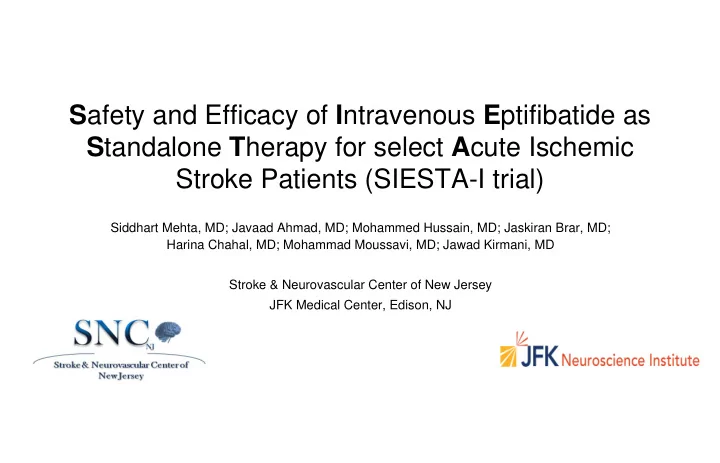

S afety and Efficacy of I ntravenous E ptifibatide as S tandalone T herapy for select A cute Ischemic Stroke Patients (SIESTA-I trial) Siddhart Mehta, MD; Javaad Ahmad, MD; Mohammed Hussain, MD; Jaskiran Brar, MD; Harina Chahal, MD; Mohammad Moussavi, MD; Jawad Kirmani, MD Stroke & Neurovascular Center of New Jersey JFK Medical Center, Edison, NJ
Trade name: Integrillin • Glycoprotein IIb/IIIa inhibitor • Reversible anti-platelet • Short half-life (2.5 hours) • Intravenous administration • Other drugs in same class – Abciximab (ReoPro) – Tirofiban (Aggrastat)
N Engl J Med 1998 Aug 13;339 (7): 436-443 Inhibition of platelet glycoprotein IIb/IIIa with eptifibatide in patients with acute coronary syndromes. The PURSUIT Trial Investigators. Platelet Glycoprotein IIb/IIIa in Unstable Angina: Receptor Suppresion Using Integrillin Therapy. Conclusion: Inhibition of platelet aggregation with eptifibatide reduced the incidence of the composite end point of death or nonfatal myocardial infarction in patients with acute coronary syndromes who did not have persistent ST-segment elevation.
CNS Drugs. 2004; 18 (14): 981-8 Pancioli AM, Brott TG. Therapeutic potential of platelet glycoprotein IIb/IIIa receptor antagonists in acute ischemic stroke: scientific rationale and available evidence. Conclusion: GP IIb/IIIa receptor antagonists are a proven component of care in ischemic coronary syndromes and have similar potential for benefit in ischemic stroke. Ongoing research offers hope.
Stroke. 2008; 39:3268-3276 Pancioli A et al. The C ombined A pproach to L ysis Utilizing E ptifibatide and r t-PA in Acute Ischemic Stroke Conclusion: The safety of combination of reduced-dose rt-PA plus eptifibatide justifies further dose-ranging trials in acute ischemic stroke.
Stroke. 2013; 44:2381-2387 Pancioli A et al. C ombined A pproach to L ysis Utilizing E ptifibatide and r t- PA in Acute Ischemic Stroke- E nhanced R egimen Conclusion: The combined regimen of inravenous rt- PA and eptifibatide studied in this trial was safe and provides evidence that a phase III trial is warranted to determine efficacy of the regimen.
S afety and Efficacy of I ntravenous E ptifibatide as S tandalone T herapy for select A cute Ischemic Stroke Patients (SIESTA-I trial) • Result of an open labeled retrospective registry to evaluate the safety (in regards to hemorrhagic complications) and efficacy (regarding discharge NIHSS) of administering high dose IV Eptifibatide as a standalone therapy for acute stroke in patients ineligible for IV r-tPa or neurointervention.
• All patients with acute ischemic events between 2010-13 were included that presented to our university affiliated comprehensive stroke center. • Patients that received Eptifibatide as standalone therapy were reviewed. Eptifibatide was administered intravenously as a 135- μg/kg single-dose bolus, then a 0.5- μg/kg/min infusion. • Charts were reviewed for all patients to assess for primary safety and efficacy endpoint.
• The primary safety endpoint was bleeding. Bleeding complications were classified as major (symptomatic intracranial hemorrhage and hemoglobin decrease by >5mg/dl), minor (hemoglobin decrease 3-5 mg/dl) and insignificant as proposed by the TIMI score (Thrombolysis in Myocardial Infarction). • The primary efficacy end point was neurological improvement/deterioration as defined by a change in discharge NIHSS by > 4 points compared to initial NIHSS respectively.
• 51 year old female presented with an 18 hour history of left facial droop, left upper and lower extremity hemiparesis (NIHSS 6). • CT head showed right basal ganglia hypodensity. • CT angiogram showed near occlusive clot at distal right Middle Cerebral Artery (MCA).
• Patient was out of time window for intravenous rt-PA or intra-arterial intervention. IV eptifibatide bolus followed by continuous drip was administered for 20 hours with improvement of NIHSS from 6 to 1 (left upper extremity drift). MRA at 72 hours revealed subtotal recanalization of Right MCA.
Of a total patient population of 2,329, 20 patients (mean age of • 73, 50% male (n=10)) received Eptifibatide administered intravenously for a mean duration of 32.5 hours (range 17-67 hours). No major or minor bleeding was observed except for a patient • who exhibited minor complication of knee hemarthroses. 9 patients demonstrated early neurological improvement with • only 2 exhibiting neurological deterioration related to extension of ischemic core.
• Application of IV Eptifibatide in achieving recanalization and preventing extension may be a safe standalone therapy in acute ischemic stroke patients ineligible for other neurological interventions. • Larger randomized trials are required to corroborate our findings.
Abciximab in Emegerncy Stroke Treatment Trial-II Stroke, 2008; 39:3277-3282 Adams H. et. Al Treating Patients with ‘Wake - Up’ Stroke. The experience of the AbESTT-II Trial. Conclusion: Halted early because of increase rate of ICH
Recommend
More recommend